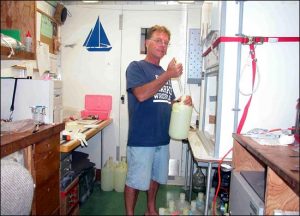Dispatch 17 – What is the Café Thorium?
If you’ve been following our VERTIGO cruise from the home page of the Café Thorium, you might be asking yourself, what does a Café have to do with ocean science? and what the heck is thorium? and what does all of this have to do with VERTIGO, our study of the sources and sinking rates of marine particles, and this cruise off Hawaii?
Well to make a long story short, our group is not the first to measure the elemental distribution of thorium in seawater, but I think we are the first to combine our skills in the marine chemistry of thorium with an appreciation for an excellent espresso. We started taking an Italian espresso machine with us on research trips about 10 years ago, at the same time we were developing improved methods for measuring thorium-234 in seawater.
Thorium is a naturally radioactive compound derived from the decay of uranium in seawater. There is more than one thorium isotope, or atomic mass for thorium, and thorium-234 is appealing to us in that it is naturally sticky, or attaches easily to particles surfaces, and it has a period of 24 days for half of the thorium atoms to be lost due to natural radioactive decay processes. This decay period of a few weeks makes thorium-234 a good “clock” to measure biological processes in the upper ocean, including the rates of particle sinking, since ocean plankton that are the source of many marine particles have cycles of growth and decay that lasts from days to weeks.

Overview of 234Th approach.
What is interesting about the cycle of thorium in seawater, is that the concentration, or amount of thorium in seawater is largely determined by the balance between its supply from uranium, and its removal on sinking particles. Since uranium concentrations are generally constant in the ocean, this means that if one measures low thorium, more thorium is hitching a ride on sinking particles and the flux of particles is high. High thorium indicates low particle fluxes. So rather than collecting sinking particles directly using sediment traps or other devices (which is not an easy task) we can calculate the rate of vertical particle flux by measuring this “tracer” or proxy for ocean particle flux.
Like all approaches, thorium is not a perfect tool, but we here at the Café Thorium have improved methods that allow us to measure thorium easier and on smaller sample sizes than in prior work and this improves our ability to learn more about the ocean with this tracer. As our methods became streamlined for thorium work, we outfitted a 20 foot long container as a mobile marine thorium lab that can be shipped around the world and placed directly on board a research vessel for our use. We added a few creature comforts like a stereo, and of course the espresso maker and voila, the Café Thorium was born.
On this VERTIGO research cruise, we have already collected and measured over 200 thorium-234 samples. We have also enjoyed coffee carried to the ship by Phil Boyd’s group from the Ripe Coffee Co. in Wellington New Zealand, and bought by our group in Honolulu at the Exquisite Coffee Company. So, our coffee tastes and skills in marine cycles take us around the world on a journey of scientific adventure, which comes together on this VERTIGO cruise.
— Ken Buesseler

Steve Pike, member of the Café Thorium group at the Woods Hole Oceanographic Institution is seen here working inside the Café Thorium mobile lab van holding a bottle used to collect and process seawater thorium-234 samples. (Photo by Ken Buesseler)